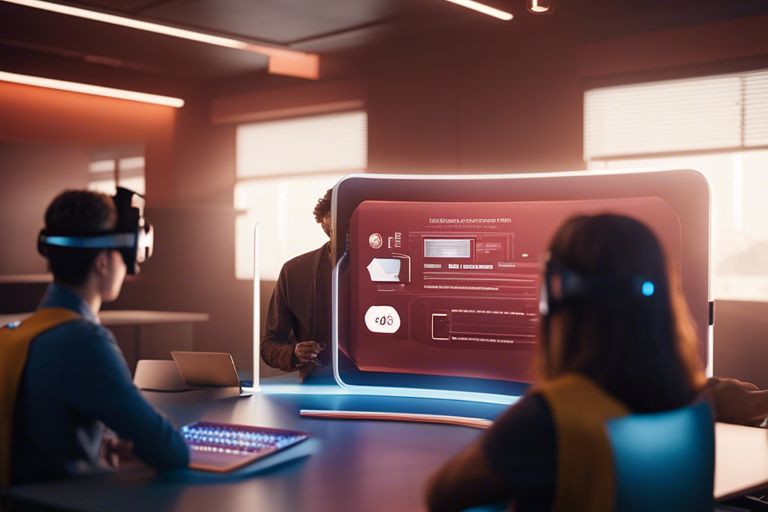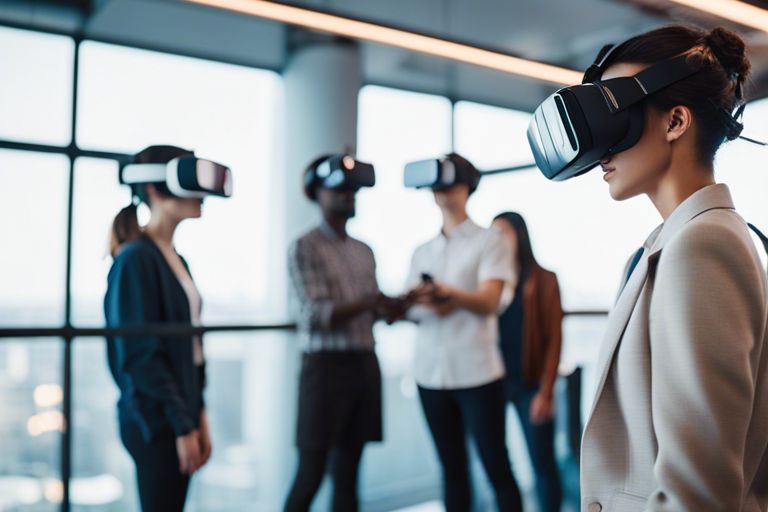AI #Virtual environments are revolutionizing education by harnessing the power of Artificial Intelligence to create immersive and interactive learning experiences. These cutting-edge technologies have the potential to transform traditional educational methods, making learning more engaging, personalized, and effective. By integrating AI into virtual reality environments, students can immerse themselves in realistic simulations, receive real-time feedback, and access adaptive learning experiences tailored to their individual needs. The convergence of AI and virtual reality opens up a world of possibilities for the future of education, ushering in a new era of innovation and opportunity.
The Current State of Education
While traditional learning environments have been the cornerstone of education for centuries, they come with their own set of limitations that hinder effective learning and engagement.
Limitations of Traditional Learning Environments
With rigid classroom structures, one-size-fits-all teaching methodologies, and limited opportunities for practical application, traditional learning environments often struggle to cater to the diverse learning needs of students. Students who learn at a different pace or have unique learning styles may find themselves left behind in such environments. Additionally, the lack of interactive and immersive experiences can make complex subjects harder to grasp for many learners.
The Need for Innovation in Education
Current educational systems are facing the pressing need for innovation to address these shortcomings and provide a more effective and engaging learning experience for students. With advancements in technology such as virtual reality (VR) and artificial intelligence (AI), there is now a growing opportunity to revolutionize the way students learn and interact with educational content. By harnessing the power of AI to personalize learning pathways and using VR to create immersive learning environments, educators can better cater to individual student needs and enhance overall learning outcomes.
To truly prepare students for the complexities of the modern world, it is crucial to embrace innovative technologies and teaching methods that foster critical thinking, problem-solving skills, and creativity. By leveraging AI-powered virtual reality environments in education, we have the potential to create a dynamic and personalized learning experience that empowers students to thrive in an ever-evolving digital landscape.
The Rise of Virtual Reality
Defining Virtual Reality and Its Applications
You may have heard of virtual reality (VR) in recent years, but what exactly is it? Virtual reality is a simulated environment created by advanced technology where the user is immersed in a 3D experience. This immersive environment is often generated by a combination of hardware and software, providing a realistic sensory experience that can include sight, sound, and even touch. The applications of VR extend far beyond gaming and entertainment, with implications for education, training, healthcare, and more. VR has the potential to revolutionize the way we learn, work, and interact with the world around us.
The Growing Popularity of VR in Various Industries
Rise As technology continues to advance, the use of virtual reality is becoming increasingly prevalent across a wide range of industries. From healthcare and architecture to automotive and retail, businesses are leveraging VR to enhance training, design, customer experiences, and more. The immersive nature of VR allows users to engage with content in a way that traditional methods simply cannot replicate.
Defining Education, for example, has seen a significant shift towards incorporating VR into classrooms to provide interactive and engaging lessons for students. In healthcare, VR simulations are being used to train medical professionals in realistic scenarios without the need for live patients. The possibilities are endless as more industries recognize the value of integrating VR technology into their practices.

The Role of AI in Virtual Reality
How AI Enhances the VR Experience
With the rapid advancements in artificial intelligence (AI) technology, the integration of AI in virtual reality (VR) environments has opened up new possibilities for enhancing the overall user experience. AI algorithms can analyze user behavior in real-time, adjusting the virtual environment to suit individual preferences and learning styles. This enables a more personalized and immersive experience for users, making learning more engaging and effective.
AI-Driven Personalization in Virtual Environments
Virtual environments powered by AI can provide tailored learning experiences based on individual progress and performance. By collecting and analyzing data on user interactions within the VR environment, AI algorithms can adapt the content to suit the needs of each user. This personalized approach helps in keeping users engaged and motivated, ultimately leading to better retention of information and improved learning outcomes.
Understanding the importance of AI-driven personalization in virtual environments is crucial for the future of education. By catering to the unique needs and preferences of individual learners, AI-powered VR environments have the potential to revolutionize the way knowledge is acquired and retained. This level of personalization can help in addressing the diverse learning styles and preferences of students, making education more accessible and effective for everyone.
The Potential of AI-Powered VR in Education
Immersive Learning Experiences
Allowing learners to step into simulated environments, AI-powered VR offers immersive learning experiences that can transport them to places they’ve never been before. With AI integration, these virtual worlds can adapt and respond to individual student actions, creating a tailor-made learning journey. Imagine studying ancient Rome by actually walking its streets or exploring the human body by shrinking down to a cellular level. The possibilities for experiential learning are endless with AI-powered VR.
Enhanced Engagement and Interaction
Enhanced by AI algorithms, VR can track student behavior and preferences, providing real-time feedback and adapting the learning content accordingly. Students can engage in interactive simulations, experiments, and challenges that make learning fun and engaging. The fusion of AI and VR in education enables a dynamic and personalized learning experience that caters to each student’s needs and learning pace.
Plus, AI-powered VR fosters collaboration and communication among students, encouraging teamwork and problem-solving skills. It also equips educators with valuable insights into each student’s progress and areas for improvement, allowing for targeted interventions and support. The seamless integration of AI and VR technologies holds the potential to revolutionize the way we learn and teach, making education more engaging, effective, and inclusive.
Virtual Field Trips and Expeditions
All around the world, educators are beginning to harness the power of virtual reality (VR) environments to enhance traditional learning methods. One of the most exciting applications of VR in education is the ability to take students on virtual field trips and expeditions without ever leaving the classroom. Imagine studying ancient civilizations and being able to virtually explore the ruins of Machu Picchu, or venturing into the depths of the ocean to learn about marine life up close. The immersive nature of VR allows students to engage with the material in a way that traditional methods simply cannot replicate.
Exploring New Frontiers in Education
For educators, virtual field trips provide a dynamic way to bring the curriculum to life and make learning more interactive and engaging. Students are no longer limited by the constraints of a physical classroom or the cost of organizing real-world excursions. With VR technology, classrooms can transform into any environment imaginable, from the surface of Mars to the intricate ecosystems of the Amazon rainforest. This technology opens up a whole new world of possibilities for educators to create unforgettable learning experiences that cater to different learning styles and abilities.
Overcoming Geographical and Financial Barriers
To make virtual field trips accessible to all students, regardless of their location or financial means, VR technology offers a solution to overcome geographical and financial barriers. Schools in remote areas or with limited resources can still provide students with the opportunity to visit far-flung destinations and historical landmarks through virtual simulations. VR environments powered by AI have the potential to level the playing field in education, offering all students the chance to explore the world beyond their immediate surroundings.
Plus, virtual field trips can be repeated and customized to suit individual learning needs. Students can revisit a virtual location multiple times, focusing on different aspects of the experience each time to deepen their understanding and knowledge. The flexibility and adaptability of VR technology make it a valuable tool for personalized learning and creating tailored educational experiences.
AI-Driven Simulations and Training
Unlike traditional educational methods, AI-driven simulations offer a dynamic and interactive way for students to engage with complex concepts.
Real-World Applications in Education
An increasing number of educational institutions are incorporating AI-powered simulations into their curriculums to enhance learning outcomes. These simulations can mimic real-world scenarios, providing students with hands-on experience in a safe and controlled environment.
Developing Critical Thinking and Problem-Solving Skills
Developing critical thinking and problem-solving skills is necessary for students to succeed in today’s rapidly changing world.
For instance, AI-driven simulations can present students with challenging scenarios where they must analyze information, make decisions, and observe the outcomes of their choices in a real-time setting. This process enables students to think critically and develop problem-solving strategies in a practical and engaging way. By actively participating in these simulations, students can hone their skills and apply theoretical knowledge to real-life situations.
Personalized Learning Paths and Adaptive Assessment
Leveraging AI for Tailored Education
For a truly immersive and effective educational experience, virtual reality environments powered by AI can offer personalized learning paths tailored to each individual’s unique strengths, weaknesses, and learning preferences. By analyzing data on how students interact with the virtual environment, AI algorithms can adapt the content, pace, and difficulty level of lessons in real-time, ensuring that the material is engaging and challenging but not overwhelming.
This tailored approach to education can help students progress at their own pace, providing extra support or challenges as needed. Students who grasp concepts quickly can move ahead, while those who struggle can receive additional explanations or practice opportunities.
Continuous Evaluation and Feedback
Assessment in virtual reality environments powered by AI goes beyond traditional tests and quizzes, offering continuous evaluation and feedback throughout the learning process. AI algorithms can track a student’s performance, identify areas of strength and weakness, and provide targeted feedback to help them improve. This real-time assessment allows educators to intervene promptly and offer personalized support to students.
Continuous evaluation and feedback are crucial components of adaptive learning, ensuring that students receive the individualized attention they need to succeed. By providing ongoing insights into a student’s progress, AI-powered assessments can help educators tailor their teaching strategies to better meet the needs of each student.
Plus, this continuous feedback loop enables students to engage more actively with the material, as they receive instant responses to their actions and can see the direct impact of their choices on their learning outcomes. This immediate feedback fosters a sense of autonomy and empowerment, motivating students to take ownership of their education and strive for continuous improvement.
Accessibility and Inclusivity in AI-Powered VR
Despite the incredible advancements in technology, accessibility and inclusivity remain critical factors in the development of AI-powered virtual reality (VR) environments for educational purposes. Any educational platform must strive to be inclusive and accessible to all, including students with disabilities. Breaking Down Barriers for Students with Disabilities
Breaking Down Barriers for Students with Disabilities
AI-powered VR has the potential to revolutionize education by offering immersive and personalized learning experiences. However, it is imperative to ensure that these platforms are designed with Accessibility in mind. Implementing features such as voice commands, audio descriptions, haptic feedback, and customizable interfaces can democratize access to quality education for students with disabilities, making learning more engaging and effective for all.
Democratizing Access to Quality Education
Breaking barriers to education, AI-powered VR environments can provide students from diverse backgrounds with equal opportunities to access high-quality educational resources. By offering interactive simulations, real-time feedback, and adaptive learning pathways, these platforms have the potential to level the playing field and bridge the educational gap. Accessibility to quality education is no longer limited by geographical location or socioeconomic status, paving the way for a more inclusive and equitable educational landscape.
The Future of Teacher-Student Interaction
Redefining the Role of Educators in AI-Powered VR
After exploring the possibilities of AI-powered virtual reality environments in education, it becomes evident that the role of educators is set to undergo a transformative shift. The integration of AI technology in VR education tools has the potential to enhance and streamline the learning process, providing personalized pathways for students. In this new landscape, educators are no longer just disseminators of information; they are curators, guides, and facilitators who leverage AI insights to tailor educational experiences to the individual needs of each student.
Humanizing the Learning Experience
Educators play a crucial role in humanizing the learning experience within AI-powered VR environments. Despite the technological advancements, the emotional connection and support that educators provide remain irreplaceable. Through personalized feedback, encouragement, and mentorship, educators can nurture students’ curiosity, creativity, and critical thinking skills in ways that AI alone cannot replicate.
Understanding the balance between technological innovation and human touch is key to creating a holistic educational experience within AI-powered VR. While AI can optimize content delivery and assessment, educators bring empathy, insight, and motivational support to help students thrive in this cutting-edge learning environment.
Addressing Concerns and Challenges
Once again, as we venture into the potential of using AI-driven virtual reality environments for education, it is crucial to address the various concerns and challenges that may arise.
Ethical Considerations in AI-Driven Education
An important aspect to consider is the ethical implications of utilizing AI in educational settings. Issues such as data privacy, bias in algorithms, and the potential for technology to replace human interaction need to be carefully examined and regulated to ensure that the use of AI in education is ethical and beneficial for all learners.
Technical Limitations and Infrastructure Needs
Concerns may arise regarding the technical limitations and infrastructure requirements for implementing AI-driven virtual reality environments in educational settings. Availability of high-speed internet, access to compatible devices, and the cost of implementing and maintaining such systems could pose challenges for widespread adoption.
Limitations: It is crucial to address technical limitations and infrastructure needs to ensure that AI-driven educational environments are accessible and effective for all learners.
Real-World Implementations and Success Stories
Not only are virtual reality (VR) environments powered by artificial intelligence (AI) revolutionizing the education sector, but they are also providing tangible results in real-world implementations. Various institutions have successfully integrated AI-powered VR into their educational programs, leading to enhanced learning experiences and improved student outcomes.
Pioneering Institutions and Their VR Initiatives
Success stories abound from pioneering institutions that have embraced AI-powered VR technology in their classrooms. For example, Harvard University has implemented AI-driven simulations in medical training, allowing students to practice complex surgical procedures in a safe and controlled environment. Similarly, Stanford University has integrated AI into VR modules for engineering students, enabling them to visualize and interact with intricate designs in a 3D space, enhancing their understanding of theoretical concepts.
Measuring the Impact of AI-Powered VR on Student Outcomes
The implementation of AI-powered VR in educational settings has sparked interest in measuring its impact on student outcomes. The use of advanced analytics and data tracking tools allows educators to assess the effectiveness of VR simulations in improving student engagement, knowledge retention, and critical thinking skills. Preliminary studies have shown promising results, indicating that students who learn through AI-powered VR demonstrate higher levels of comprehension and information recall compared to traditional methods.
Pioneering institutions are at the forefront of this educational revolution, utilizing AI-powered VR to break new ground in how students learn and interact with complex subject matter. The integration of AI algorithms enhances the adaptability and personalization of VR environments, catering to individual learning styles and preferences. As more institutions invest in this technology, the potential for transforming education through immersive and intelligent virtual experiences continues to expand.
The Economic and Societal Implications
Investing in the Future of Education
Future advancements in virtual reality environments powered by AI present a revolutionary opportunity to invest in the future of education. By leveraging AI technology, educational institutions can create immersive and personalized learning experiences that cater to individual student needs. This tailored approach has the potential to significantly enhance student engagement and knowledge retention, ultimately leading to better educational outcomes. Investing in these cutting-edge technologies can pave the way for a more efficient and effective educational system.
Preparing Students for an AI-Driven Workforce
Future-proofing students for an AI-driven workforce is crucial in today’s rapidly evolving job market. Virtual reality environments powered by AI offer a unique platform for students to develop the skills needed to excel in an increasingly automated world. By integrating AI technology into education, students can gain hands-on experience with artificial intelligence, preparing them for the careers of tomorrow. These immersive learning experiences not only equip students with technical skills but also foster critical thinking, problem-solving, and creativity.
Societal: As AI continues to reshape industries across the globe, preparing students for an AI-driven workforce is crucial for ensuring their future success. By exposing students to AI-powered virtual reality environments early on, educational institutions can empower them to adapt to the changing landscape of work and technology. This proactive approach can help bridge the skills gap and create a workforce that is not only knowledgeable in AI but also adept at leveraging its potential for innovation and growth.
The Road Ahead
Overcoming Hurdles and Embracing Change
Embracing the integration of AI-powered virtual reality environments into education comes with its challenges and resistance. One major hurdle is the potential reluctance of traditional educational institutions to adopt such innovative technologies due to concerns about cost, training, and reliability. Another challenge is ensuring equitable access to these tools for all students, regardless of their socio-economic backgrounds. However, embracing these changes can lead to incredible advancements in personalized learning experiences, student engagement, and knowledge retention.
Collaborative Efforts and Research Directions
Efforts to drive the future of AI-powered virtual reality in education will require collaborative initiatives between educators, technologists, researchers, and policymakers. By working together, these stakeholders can address key issues such as data privacy, content quality, and ethical considerations. Research directions should focus on understanding the cognitive impact of immersive technologies on learning outcomes, developing interactive and adaptive learning environments, and exploring the potential of AI tutors to provide personalized assistance to students.
Change is inevitable, and as we navigate the intersection of AI, virtual reality, and education, it is crucial to prioritize ethical practices, diversity, and inclusion. By embracing this technological revolution in education and fostering collaborative efforts towards its advancement, we can shape a more engaging, effective, and accessible learning landscape for future generations.
Summing up
As a reminder, exploring the intersection of virtual reality environments and artificial intelligence in education has the potential to revolutionize how we learn and engage with educational content. The immersive and adaptive nature of these technologies could personalize educational experiences, making learning more interactive and captivating for students of all ages.
By harnessing the power of AI in virtual reality environments, educators can create customized and dynamic learning experiences that cater to individual needs and learning styles. This fusion of innovation holds the promise of unlocking new educational frontiers, shaping the future of learning in ways we have yet to fully grasp. Exciting times lie ahead as we explore deeper into the possibilities that lie at the crossroads of AI and virtual reality in education.
FAQ
Q: What are Virtual Reality Environments?
A: Virtual Reality Environments are computer-simulated three-dimensional spaces that allow users to interact with a simulated environment as if they were physically present in that space.
Q: How is Artificial Intelligence (AI) utilized in Virtual Reality Environments?
A: AI is used in Virtual Reality Environments to enhance user experiences by providing intelligent interactions, personalization, and adaptive learning capabilities.
Q: What role can AI play in Virtual Reality Education?
A: AI can revolutionize Virtual Reality Education by tailoring content to the individual learner, providing personalized feedback, and creating immersive educational experiences.
Q: How can AI-powered Virtual Reality benefit learners?
A: AI-powered Virtual Reality can enhance learning outcomes by offering interactive and engaging experiences, adapting to individual learning styles, and providing real-time feedback.
Q: Are there any challenges in integrating AI into Virtual Reality Education?
A: Yes, challenges such as data privacy concerns, the need for quality content creation, and ensuring equitable access to AI-powered Virtual Reality tools need to be addressed.
Q: How can Virtual Reality Environments powered by AI shape the future of education?
A: Virtual Reality Environments powered by AI have the potential to revolutionize education by offering personalized, immersive, and engaging learning experiences that can cater to diverse learning needs.
Q: What are some examples of AI-powered Virtual Reality applications in education?
A: Examples include virtual labs for science experiments, simulations for vocational training, immersive language learning experiences, and interactive history lessons, all enhanced by AI capabilities.




